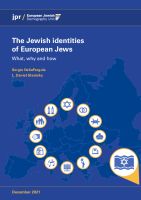The Jewish identities of European Jews: What, why and how
Author(s)
Publication Date
December 2021
Publication Place
Publisher
Abstract
Throughout 2021, JPR researchers Professor Sergio DellaPergola and Dr Daniel Staetsky analysed the responses of over 16,000 European Jews in 12 European countries who participated in the European Union Agency for Fundamental Rights survey conducted by JPR and Ipsos in 2018. The result of their hard work and innovative approach is ‘The Jewish identities of European Jews’, a study into the what, why and how of Jewish identity.
The report finds some extraordinary differences and similarities between Jews across Europe, including:
European Jews are much more likely to see themselves as a religious minority than an ethnic one, yet fewer than half of all Jewish adults across Europe light candles most Friday nights;
Jewish identity is strongest in Belgium, the UK, France, Austria, Spain and Italy, and weakest in Hungary and Poland;
The memory of the Holocaust and combating antisemitism played a more important part in people’s Jewish identity than support for Israel, belief in God or charitable giving. Rising perceptions of antisemitism may have stimulated a stronger bond with Jewish peoplehood;
Only about half of all Jews in Europe identify with a particular denomination, although there are significant differences at the national level;
Higher proportions of younger Jews are religiously observant than older Jews;
Belgium has the largest proportion of Jews identifying as Orthodox in its Jewish population, followed by the UK, Italy, France and Austria;
Spain has the largest proportion of Jews identifying as Reform/Progressive, followed by Germany and the Netherlands;
Levels of attachment to the European Union among European Jews are higher than, or very similar to, levels of attachment among their fellow citizens in the countries in which they live
The report finds some extraordinary differences and similarities between Jews across Europe, including:
European Jews are much more likely to see themselves as a religious minority than an ethnic one, yet fewer than half of all Jewish adults across Europe light candles most Friday nights;
Jewish identity is strongest in Belgium, the UK, France, Austria, Spain and Italy, and weakest in Hungary and Poland;
The memory of the Holocaust and combating antisemitism played a more important part in people’s Jewish identity than support for Israel, belief in God or charitable giving. Rising perceptions of antisemitism may have stimulated a stronger bond with Jewish peoplehood;
Only about half of all Jews in Europe identify with a particular denomination, although there are significant differences at the national level;
Higher proportions of younger Jews are religiously observant than older Jews;
Belgium has the largest proportion of Jews identifying as Orthodox in its Jewish population, followed by the UK, Italy, France and Austria;
Spain has the largest proportion of Jews identifying as Reform/Progressive, followed by Germany and the Netherlands;
Levels of attachment to the European Union among European Jews are higher than, or very similar to, levels of attachment among their fellow citizens in the countries in which they live
Topics
Jewish Identity Main Topic: Identity and Community Religious Observance and Practice Religious Denominations Surveys Age and Generational Issues National Identity
Genre
Geographic Coverage
Austria Belgium Denmark France Germany Hungary Europe Italy Netherlands Poland Spain Sweden United Kingdom
Original Language
Related
Experiences and perceptions of antisemitism: Second survey on discrimination and hate crime against Jews in the EU (Responding to)
DOI
Link
Link to article including link to pdf, The Jewish identities of European Jews: What, why and how
Bibliographic Information
The Jewish identities of European Jews: What, why and how. . December 2021: https://archive.jpr.org.uk/10.64359/o0buz7ale




